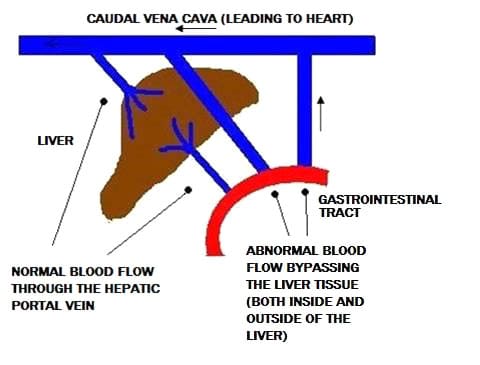Liver shunt in dogs: symptoms, diagnosis and treatment
Liver shunt in dogs is a serious condition that can represent a life-threatening situation for the affected dog. It is a malformation of the liver that causes venous blood to drain into the systemic circulation. This condition is also known as portosystemic shunt (PSS).
In this article, we will look at the symptoms, diagnosis and treatment options for liver shunt in dogs.

(C) https://www.ufaw.org.uk/dogs/yorkshire-terrier-portosystemic-shunt
Symptoms:
The symptoms of liver shunt in dogs can vary widely and vary depending on the severity of the disease. Some of the most common symptoms are:
- Vomit
- Diarrhea
- weight loss
- Loss of appetite
- inertia
- Seizures
- blindness
- Behavioral changes
- Neurological disorders
If you notice one or more of these symptoms in your dog, you should definitely see a veterinarian for a diagnosis.
Diagnosis:
Diagnosing liver shunting in dogs can be challenging because the symptoms are not specific and can occur with other diseases. However, an experienced veterinarian will be able to perform a thorough clinical examination and perform further tests to confirm the diagnosis.
Tests that may be performed to diagnose liver shunt in dogs include:
- Blood tests: A blood test can reveal abnormalities in liver enzymes or the dog's blood work.
- Ultrasound: An ultrasound of the liver can help identify the shunt.
- Contrast study: A contrast study may be used to locate the shunt and determine its size and location.
- Computed tomography (CT): A CT scan can be used to more precisely locate the shunt.
- Magnetic Resonance Imaging (MRI): An MRI scan can also be used to diagnose liver shunting in dogs.
Treatment:
Treatment of liver shunt in dogs depends on the severity of the disease. For some dogs, a change in diet may be sufficient, while others may require surgical treatment.
the diet can help relieve symptoms and stabilize the dog's condition. A low-protein diet can help reduce stress on the liver. Your veterinarian can recommend what type of diet is best for your dog.
Surgical treatments may be used to eliminate or reduce the size of the shunt. The two most common surgical procedures are:
- Ameroid Constrictor: This method involves placing an ameroid constrictor around the shunt to reduce blood flow and ultimately close the shunt.
- Ligation : In this method, the shunt is directly ligated or tied to stop the abnormal blood flow.
Surgical treatment should only be performed by an experienced veterinary surgeon who specializes in the treatment of canine liver shunts.
If surgical treatment is not possible or has not been successful, medications be used to control symptoms. Some of the most commonly used medications are:
- Lactulose: Lactulose helps bind and remove ammonia in the intestines.
- Antibiotics: Antibiotics may be prescribed to control the growth of harmful bacteria in the intestines.
- Vitamin K: Vitamin K is prescribed to prevent bleeding that can be caused by impaired blood clotting.
FAQs:
Can liver shunt in dogs be prevented?
There is no way to prevent liver shunt in dogs as it is a congenital condition. However, there are some steps you can take to ease symptoms and improve your dog's well-being.
How long can a dog live with a liver shunt?
The life expectancy of a dog with a liver shunt depends on the severity of the disease. Some dogs can live relatively normal lives, while others have a limited life expectancy.
How often should dogs with liver shunts have vet visits?
Dogs with liver shunts should be monitored regularly by a veterinarian to ensure their symptoms are under control and to identify possible complications.
Summary
Liver shunt in dogs is a serious condition that requires timely diagnosis and treatment. Symptoms can be nonspecific, so it's important to be alert to any changes in your dog's behavior or health.
Thorough diagnosis and treatment by an experienced veterinarian can help relieve symptoms and improve your dog's life. If you suspect that your dog is suffering from liver shunt, do not hesitate to consult a veterinarian for a diagnosis and appropriate treatment.
outlook
Current research is still looking for the causes of liver shunting in dogs. It is thought that genetic factors may play an important role in the development of the disease.
Various non-invasive diagnostic techniques such as the use of ultrasound, magnetic resonance imaging (MRI), and specific blood tests have also been studied. These techniques can help facilitate the diagnosis of liver shunt in dogs and enable early detection of the condition.
New surgical techniques and medications are also being sought to treat liver shunting in dogs. Some studies have shown that a combination of surgery and drug therapy can effectively relieve symptoms.
In addition, the use of diets with reduced protein and ammonia content to relieve the symptoms of liver shunt in dogs is also being investigated.
Overall, current research continues to search for ways to improve the diagnosis and treatment of liver shunts in dogs and to increase the quality of life of affected dogs.
